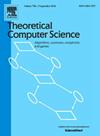从最快路径实现时间图
IF 1
4区 计算机科学
Q3 COMPUTER SCIENCE, THEORY & METHODS
引用次数: 0
摘要
在本文中,我们开始研究时间图在其顶点之间的最快路径持续时间方面的实现问题,而我们关注的是周期时间图。给定一个n×n矩阵D和一个Δ∈N,目标是构建一个包含N个顶点的Δ-periodic时间图,使得从vi到vj的最快路径的持续时间等于Di,j,或者决定这样的时间图不存在。自20世纪60年代以来,问题在静态图上的变化已经得到了很好的研究和理解(例如[Erdős and Gallai, 1960], [Hakimi and Yau, 1965])。事实证明,周期时间图实现问题与静态(即非时间)对应问题具有非常不同的计算复杂性行为。首先,我们证明了这个问题一般来说是np困难的,但如果所谓的底层图是树的话,它是多项式时间可解的。在这些结果的基础上,我们研究了它的参数化计算复杂性,相对于测量“树形”的底层静态图的结构参数。我们证明了这些参数之间的紧密分类,允许固定参数可追溯性(FPT)和那些暗示w[1]-硬度。我们表明,当用底层图的反馈顶点数(以及任何较小的参数,如树宽、退化和cliquewidth)参数化时,我们的问题是W[1]-hard,而当用底层图的反馈边数(以及任何较大的参数,如最大叶数)参数化时,我们的问题是FPT。本文章由计算机程序翻译,如有差异,请以英文原文为准。
Temporal graph realization from fastest paths
In this paper, we initiate the study of the temporal graph realization problem with respect to the fastest path durations among its vertices, while we focus on periodic temporal graphs. Given an matrix D and a , the goal is to construct a Δ-periodic temporal graph with n vertices such that the duration of a fastest path from to is equal to , or to decide that such a temporal graph does not exist. The variations of the problem on static graphs have been well studied and understood since the 1960s (e.g. [Erdős and Gallai, 1960], [Hakimi and Yau, 1965]). As it turns out, the periodic temporal graph realization problem has a very different computational complexity behavior than its static (i.e., non-temporal) counterpart.
First, we show that the problem is NP-hard in general, but polynomial-time solvable if the so-called underlying graph is a tree. Building upon those results, we investigate its parameterized computational complexity with respect to structural parameters of the underlying static graph which measure the “tree-likeness”. We prove a tight classification between such parameters that allow fixed-parameter tractability (FPT) and those which imply W[1]-hardness. We show that our problem is W[1]-hard when parameterized by the feedback vertex number (and therefore also any smaller parameter such as treewidth, degeneracy, and cliquewidth) of the underlying graph, while we show that it is in FPT when parameterized by the feedback edge number (and therefore also any larger parameter such as maximum leaf number) of the underlying graph.
求助全文
通过发布文献求助,成功后即可免费获取论文全文。
去求助
来源期刊

Theoretical Computer Science
工程技术-计算机:理论方法
CiteScore
2.60
自引率
18.20%
发文量
471
审稿时长
12.6 months
期刊介绍:
Theoretical Computer Science is mathematical and abstract in spirit, but it derives its motivation from practical and everyday computation. Its aim is to understand the nature of computation and, as a consequence of this understanding, provide more efficient methodologies. All papers introducing or studying mathematical, logic and formal concepts and methods are welcome, provided that their motivation is clearly drawn from the field of computing.
 求助内容:
求助内容: 应助结果提醒方式:
应助结果提醒方式:


